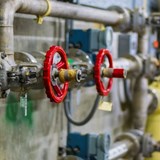Complex motion control problems arise from fluid or gas power applications because no matter the medium, it doesn’t respond to control inputs in a linear way. The decision to use closed loop or open loop control depends on the feedback and how the motion system utilizes it.
When to Use Closed Loop Control:
Closed loop control allows for precise following of motion profiles, repeatable motion, high speed and accuracy, and lower maintenance costs through smoother motion. Depending on the needs of the application, closed loop control is attainable with different levels of sophistication or complexity. Some analog controllers operate with proportional control. The controllers drive output changes as a function of the difference between the actual and target temperature or flow. Applications that need profile synchronization or gearing of one axis over another should use closed loop control. The closed loop system is best for solutions that need to maintain precision with changing loads or environmental conditions.
When to Use Open Loop Control:
Open loop control is not as precise as closed loop. They are easy to set up, don’t require tuning, support high speed motion, and are less susceptible to unwanted motion if a load is suddenly removed. Because of that, open loop control is better suited for systems where precise positioning or velocity control of the actuator isn’t critical. In open loop systems there is no control device attempting to match the actual velocity of the fluid or gas being exerted to an inputted target value. There is a desired target, but how the system arrives at that target isn’t important. The open loop system is used when speed is the most important factor, and precision is secondary.
Courtesy of Kelly Pneumatics.


